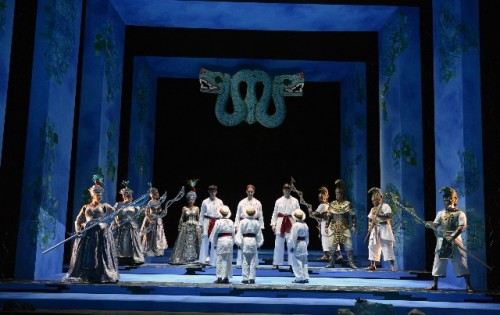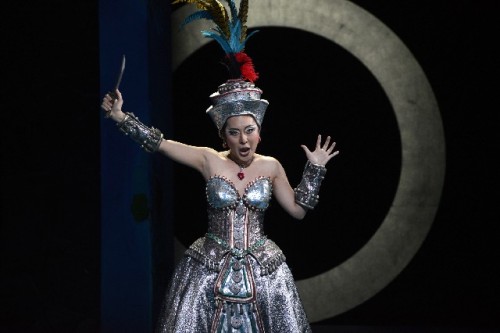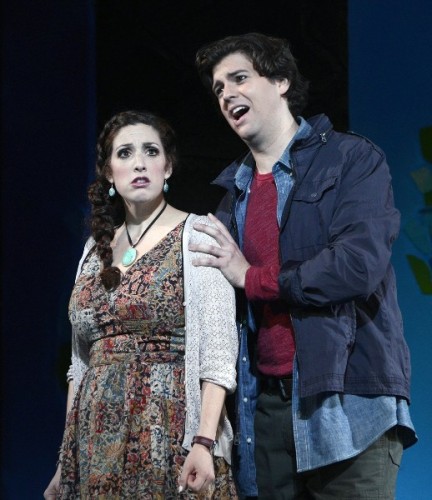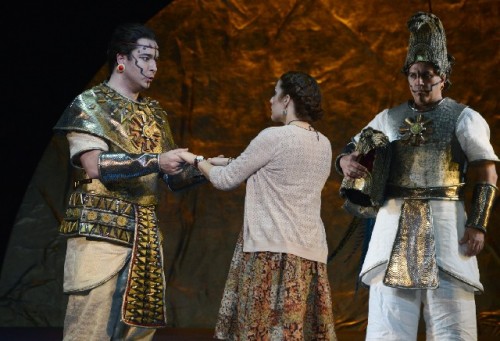Boston Lyric Opera's New The Magic Flute
BLO Strips Work of Its Masonic Subtext
By: David Bonetti - Oct 07, 2013
The Magic Flute
Music by Wolfgang Amadeus Mozart
Libretto by Emanuel Schikaneder
English adaptation by Kelley Rourke, Leon Major and John Conklin
Boston Lyric Opera
Shubert Theatre, Boston
Oct, 4, 6, 9, 11, 13
Conductor: David Angus
Stage Director: Leon Major
Set Designer: John Conklin
Costume Designer: Nancy Leary
Lighting Designer: Mark Stanley
Cast: Zach Borichevsky (Tamino), Deborah Selig (Pamina), Andrew Garland (Papageno), Neal Ferreira (Monostatos), So Young Park (Queen of the Night), Sarastro (David Cushing), Papagena (Chelsea Basler), First Lady (Meredith Hansen), Second Lady (Michelle Trainor), Third Lady (Nicole Rodin), First Spirit Messenger (David Kravitz), Second Spirit Messenger (Omar Najmi), Third Spirit Messenger (Isaac Bray), Three Boys (Thomas Potts, Timothy O’Brien, Andrew Peruzzi)
Advance word on Boston Lyric Opera’s new production of Mozart’s eternally popular “The Magic Flute” was not reassuring. It was being done not just in an English translation but in a severely cut English-language adaptation. And it was being set, not in the vague ancient Egypt of the original, but in present day Yucatan, where the principal characters were being introduced as four American college students visiting the ancient Mayan ruins rather than a Prince and Princess and a pair of plebes on a quest. What’s more, the drama was reportedly going to be set in action when the hero Tamino, renamed Tommy, is bit by a snake and hallucinates the rest of the story, the dressed-down quartet mingling with fantastically costumed mythic characters. I feared that Pagageno might be renamed Papa Gino and deliver pizzas as well as catch birds.
Not to worry. It all turned out fine. The BLO put on a very entertaining evening. And it most radical interventions successfully contributed to the general enjoyment. Although “The Magic Flute” (“Die Zauberflöte” in the original German) is filled with lovely arias and vocal ensembles, including a couple of show stoppers for the evil Queen of the Night, it is often as much of a trial to sit through as Tamino is made to endure in his quest for wisdom. The work isn’t really an opera but a singspiel, a genre of theater with spoken texts punctuated by arias and musical ensembles - like a Broadway musical - that was popular in Vienna in the 18th century. The work has a heavy Masonic subtext that involves the hero passing a series of trials that tends to leave anyone not schooled in Masonic ritual – that would include me – far behind and bored. Listening to lengthy speeches in spoken German on achieving Masonic wisdom, even with supertitles, defines tedium.
The BLO was smart to cut much of the Act II spoken text and to present the whole thing in English, a practice I in general don’t like – no one wants to hear “Tosca” or “Carmen” in English translation – but which tends to work in works by Mozart. And a major strength of the production was the witty rhyming text written by Kelley Rourke with an assist from the stage director and set designer. It was so much fun that one hopes that other companies that want to make “The Magic Flute” the enjoyable entertainment it was intended to be by its creators take it up. Altogether nearly a half hour of spoken text was cut.
The arcane Masonic material minimized, the opera essentially becomes a fairy tale with the requisite magic elements. The hero Tamino is bitten by a snake – in both the original and in the BLO adaptation – and is saved by three mysterious ladies who, after drooling over his beauty, introduce him to the imperious Queen of the Night, who enlists him to save her daughter from an evil sorcerer. Shown a picture of her Pamina, Tamino falls instantly in love, singing one of Mozart’s loveliest tenor arias to her image, and sets off to liberate her. He is accompanied by a sidekick, a bird catcher named Papageno, a Natural Man of basic desires for food, drink and sex, who also seeks a wife. To protect them, the Three Ladies present Tamino with the magic flute of the title, while Papageno is given a set of magic bells.
When they meet the sorcerer Sarastro, however, Tamino discovers that he is a man of wisdom and kindness and that Pamina is his daughter by the Queen when night and day were united and the world was whole. Sarastro has had her abducted from her furious mother for her own good; however, she is being menaced by one of Sarastro’s servants, the evil Monostatos. (And why does this paragon of wisdom have a would-be rapist in his employ?)
Sarastro, who sings some of the noblest music for bass voice in all opera, agrees to let the two young people marry, but first Tamino must pass a series of trials. He does, they marry; Papageno finds his own true love, Papagena; and the Queen of the Night is thwarted in her final attempt to free Pamina and destroy Sarastro’s power.
The opera is structured by oppositions – night and day, dark and light, evil and good; and the number three – three ladies, three boys, three trials, three ideals – wisdom, reason and nature. As in most fairy tales, good triumphs in the end and important life lessons are learned.
But what commends “The Magic Flute” to the opera-going public – it is one of the most often performed operas in the repertoire – is Mozart’s glorious music. Even when presented a flimsy libretto with stock characters meant to carry tacked-on allegorical meaning, Mozart created sublime music, endowing his characters with three-dimensionality.
All was not perfect in the BLO season premiere, however. The company boasted that the cast was composed entirely of singers with Boston connections, but in their skimpy biographies, it failed to detail how and when. Most of the singers were young, and it showed. Their performances ranged from the professionalism of those who have been on the stage frequently to the awkwardness of those who are still getting used to singing and acting at the same time before a paying audience. There was a sense that one was attending a student production, which is not all that bad – the local music schools often put on excellent productions – but you expected more from the major opera company in town, especially when it went to the trouble of commissioning a new performing edition.
No complaints about the orchestral playing: Music director David Angus led the orchestra in a lithe and stylish performance.
Some of the singers audibly and dramatically improved as the evening progressed, a sign perhaps of lack of adequate rehearsal time. In her first appearance as the Queen of the Night, So Young Park’s voice was weak and wobbly. The first of her spectacular coloratura arias was disappointingly earth-bound. But in Act II, when she sings an even more hair-raising aria, she was in fine voice, hitting each note in its center and turning out thrilling high notes. Similarly, David Cushing’s Sarastro lacked authority both audibly and dramatically when he first appeared, but when he sang the second of his great arias he inhabited the role fully and sang movingly. And when they first showed up in their quasi-Indian headdresses, the Three Ladies seemed to be singing against each other. Soon, however, they were blending their voices in the sweet manner Mozart intended.
More problematic was the pair of lovers at the center of the story. Actually, Zach Borichevsky’s Tamino sang sweetly with an easy professionalism, but he was a bland presence who should, but didn’t, betray his noble stature even while dressed in college casual. His biography notes that he is appearing this season as Alfredo (“La Traviata”) at Glyndebourne, the elite English summer opera festival, and as Rodolfo (“La Boheme”) at the Finnish National Opera. He better develop a little more stage presence for those two big tenor roles. Of course, it was easy to understand why he exhibited little passion for his beloved Pamina, who was dressed in the dowdiest outfit on the stage. But the problem was that soprano Deborah Selig wasn’t right for the role. She had to force her voice unpleasantly to hit every high note, and she sang in general with little vocal allure.
The singers filling out the smaller roles were all fine. A special shout-out to the Three Boys, students of the St. Paul Choir School in Cambridge. Who doesn’t fall for the piping sound of the boy soprano? They were adorable in their white suits with red sashes and straw hats, and none of their voices broke.
The best singers and actors of the evening were Andrew Garland as Papageno and Neal Ferreira as Monostatos. Ferreira acted with the sleaziness the role requires and sang with a lovely voice. And he electrified an often-stolid evening with a loose-limbed dance when he was diverted from menacing Pamina by the sound of magic bells. Garland was an ideal Papageno, endearing in his humanity. His baritone was steady, evenly produced and pleasant, and he showed a real flair for acting. He was all too human in the scene when he threatens suicide but keeps on looking for someone to rescue him from the act he clearly does not want to commit. One of the musical highlights of the evening, as it is inevitably in every production of the opera, was the infectious quasi-comic love duet he sang with his Papagena, Chelsea Basler, who was excellent in her few moments on stage.
It’s too bad Garland was deprived of a costume that signified his role as bird-catcher. Traditionally, Papageno and Papagena are both costumed in feathers to the great delight of audiences of all ages.
While the production was for the most part attractive, it had a number of problems. John Conklin’s use of enlarged images of turquoise Mayan snakes was inspired, but the shifting blue structures that defined places and spaces were cheesy. (Maybe if the lights were turned down they wouldn’t look so cut-rate.) Worse was Nancy Leary’s concept for the costumes. The magical characters, especially the Queen of the Night and her attendant Three Ladies, wore attractive storybook costumes, and when they first appeared as students on a field trip, Tamino and Pamina, Papageno and Monostatos were appropriately grungily garbed. But after Tamino, er, Tommy, gets bitten by the snake and they enter the world of fantasy and magic, their down-fashion outfits are totally wrong. Wasn’t there a way for Papageno to quickly slip on a bird-catcher’s outfit and for Tamino and Pamina to somehow show through dress their elevated station? Pamina in particular suffered as a character in her ugly cotton dress and cardigan.
But don’t let these complaints, which limited the production’s overall success, detract from the point I originally made that it was a very entertaining evening and that by stripping “The Magic Flute” of its quasi-philosophical trappings, the BLO team returned it to a simpler but truer fairy tale about love and the exalted attainment of wisdom, reason and nature.







